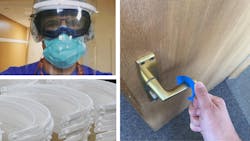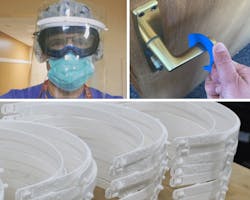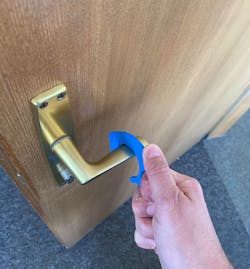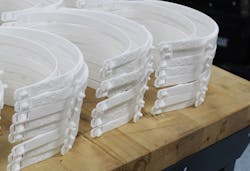Functioning critical infrastructure is essential during any emergency. But, unlike traditional emergencies where the goal of every business is to get back on track, the COVID-19 emergency centers around the goal of slowing the spread of the coronavirus while also maintaining resilience.
In assessing the implications, Eaton considered it a special responsibility to ensure access to necessities, according to Srinivas Garimella, global head of the Additive Manufacturing Center of Excellence at Eaton.
In the following Q&A, Garimella explains why the power management company made the strategic decision to maintain operations, and how the company used its additive manufacturing capabilities to provide critical personal protective equipment (PPE) support.
Machine Design: How is Eaton helping in the fight against COVID-19?
Srinivas Garimella: Eaton is a power management company. That means we help customers around the world effectively use power. Our electrical solutions form the backbone of a safe, reliable electricity supply and our mission-critical support is foundational across essential industries.
We made the important decision to maintain operations during the COVID-19 crisis because our products are critical to our global infrastructure. For example, back in February, China built two field hospitals in Wuhan in just 10 days, and our regional team helped make that happen by providing electrical solutions. Here in the U.S., we recently powered the rapid medical capacity expansion for New York’s largest healthcare provider, Southside Hospital on Long Island, to treat coronavirus patients. We also delivered power distribution equipment for temporary medical facilities at Stony Brook University hospital in New York. We’re continuing to operate in order to help communities around the world maintain critical operations with uninterrupted power.
In addition to providing power management solutions, we leveraged our additive manufacturing expertise to rapidly address critical PPE shortfalls. We developed face shields that are comfortable and can be sanitized and used again and again. We also developed a four-inch touchless tool so that people can avoid contact with surfaces and slow the spread of the novel coronavirus. The device helps open doors, twist faucets and push buttons without touching potentially contaminated surfaces.
MD: How much PPE is Eaton producing?
SG: We’re able to provide customers with the PPE they need. So far, we’ve supplied hundreds of thousands of face shields and non-contact tools in the fight against COVID-19:
- We donated the first batch of face shields made at our Additive Manufacturing Center of Excellence to hospitals in Ohio, New York, New Jersey and Michigan.
- With regional manufacturing partners, we’re delivering 360,000 face shields to Ohio medical workers.
- The first run of our touchless tools was delivered to University Hospitals in Northeast Ohio, where doctors, nurses and emergency medical technicians are using the device.
- Our team sent care packages with both face shields and touchless tools to facility managers at 25 hospitals across the U.S.
- Now, we’re supplying face shields and touchless tools across the country through our electrical distributors and channel partners.
MD: How did additive manufacturing support the development of PPE?
SG: For years, we’ve been applying additive manufacturing across our business. This approach enables our teams to quickly refine product designs based on customer feedback and easily scale production. Now, more than ever, time is of the essence.
Our additive manufacturing capabilities were instrumental to the fast-paced design incorporating customer feedback and the ability to easily scale production to meet the immediate needs of customers and communities around the world. We compressed a six- to nine-month design process into about two weeks—from proof of concept all the way to scalable manufacturing for both face shields and our new touchless tool.
MD: What do you see as the power of additive manufacturing? How do you use it during normal times?
SG: The equipment is ideally suited to produce low-volume, complex geometry parts that cannot be readily produced by traditional manufacturing processes. Additive manufacturing opens up new opportunities to combine novel materials, designs and process innovations at a much faster pace than traditional manufacturing. It enables our engineers with quick and cost-effective design iterations to dramatically reduce development time—delivering cost, performance and lead time benefits for our customers.
We launched our Southfield, Mich. Additive Manufacturing Center of Excellence (CoE) in 2016, attained AS9100 quality certification in 2018 and have been supplying parts to our customers.
Our Additive Manufacturing CoE has helped us meet increasing demand for complex, high-performance components, tools and fixtures, while advancing sustainable manufacturing and compressing product development time. Last year, for instance, we developed an aluminum housing and valve for an aerospace customer. Additive manufacturing helped us consolidate 22 parts into two printed parts, reduce assembly time and improve performance. It also helped our teams reduce part weight and shorten the overall product development time by 50%.
We’re applying our advanced manufacturing capabilities as well as our strong network of partners to support the needs of our customers and communities, both in times of crisis and during normal operation. Now, in the battle against COVID-19, we’re using that expertise to develop much-needed supplies, including face shields and non-contact tools.
MD: Who did Eaton work with to refine the designs of the face shields, touchless tools and other essential pieces of PPE?
SG: Our strong network of partners was essential to responding quickly to personal protective equipment shortfalls. For example, our teams collaborated with multiple hospitals and Cleveland’s Manufacturing Advocacy and Growth Network (MAGNET) to optimize the face shield design for safety, comfort and production. University Hospitals in Northeast Ohio collaborated on the design and development of the new Eaton touchless tool. We’re working with local manufacturing partners to scale up production of PPE to deliver the volume needed to meet demands of customers across the country and around the world.
MD: How else is Eaton helping amid this pandemic?
SG: We made the important decision to maintain operations during this unprecedented crisis because of the vital role our company plays in sustaining global infrastructure and ensuring critical power supply.
Our products and support services are vital to hospitals, emergency services, military sites, utilities, public works, transportation and shipping providers. In addition, OEMs, data centers, retail outlets, airports and governments, as well as the networks that support schools and remote workers, rely on our products each day to serve their customers and communities.
We’re committed to helping the communities where we live and work by taking steps to aid in the fight against COVID-19. Whether it’s donating much needed supplies to healthcare providers, or providing our power management expertise across critical industries, we’re here to help.
About the Author

Leaders relevant to this article:



